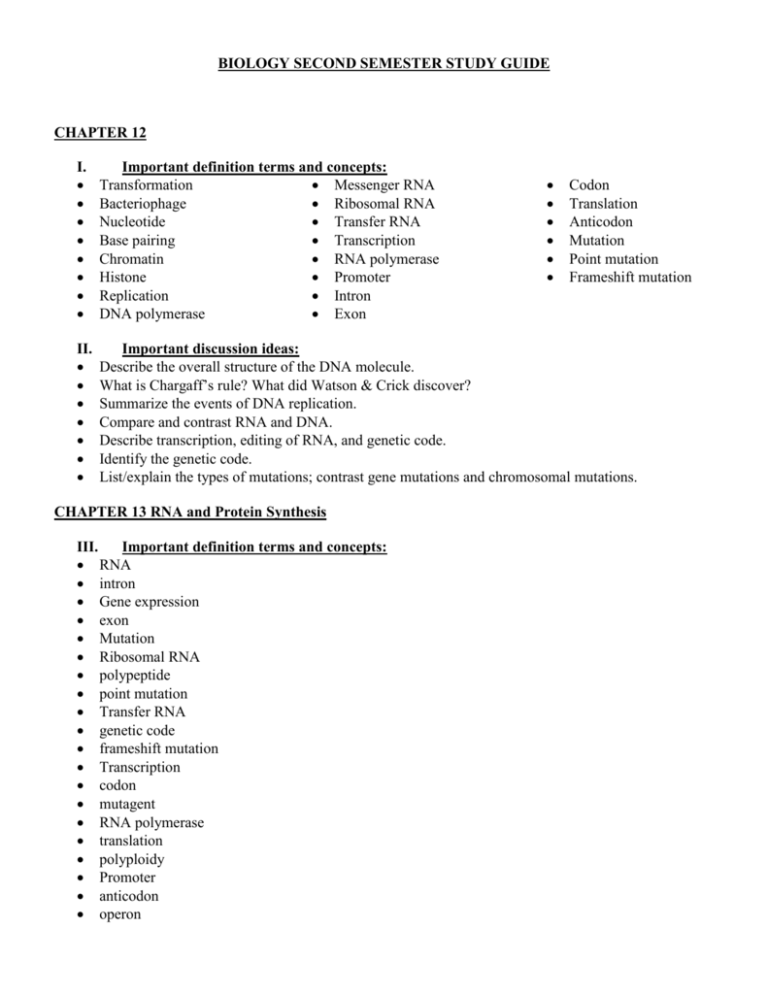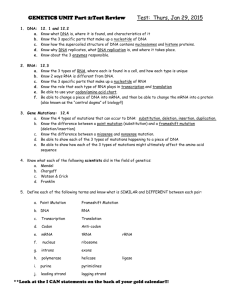BIOLOGY SECOND SEMESTER STUDY GUIDE
advertisement

BIOLOGY SECOND SEMESTER STUDY GUIDE CHAPTER 12 I. Important definition terms and concepts: Transformation Messenger RNA Bacteriophage Ribosomal RNA Nucleotide Transfer RNA Base pairing Transcription Chromatin RNA polymerase Histone Promoter Replication Intron DNA polymerase Exon II. Important discussion ideas: Describe the overall structure of the DNA molecule. What is Chargaff’s rule? What did Watson & Crick discover? Summarize the events of DNA replication. Compare and contrast RNA and DNA. Describe transcription, editing of RNA, and genetic code. Identify the genetic code. List/explain the types of mutations; contrast gene mutations and chromosomal mutations. CHAPTER 13 RNA and Protein Synthesis III. Important definition terms and concepts: RNA intron Gene expression exon Mutation Ribosomal RNA polypeptide point mutation Transfer RNA genetic code frameshift mutation Transcription codon mutagent RNA polymerase translation polyploidy Promoter anticodon operon Codon Translation Anticodon Mutation Point mutation Frameshift mutation operator IV. Important discussion ideas: How is the genetic code read? What are mutations? What are the effects of mutations on genes? What role does the ribosome play in assembling proteins? Compare and contrast DNA and RNA. Chapter 16 Evolution Explain how the finches and tortoises that Charles Darwin observed on the Galápagos Islands influenced his thinking. Suppose selective breeding has produced a population of very similar chickens. Would that population survive if it were released into the wild? Explain. State a general observation that Charles Darwin made about organisms and their environments. What evidence did Charles Darwin collect in addition to specimens of organisms alive during his time? Discuss Jean-Baptiste Lamarck’s contribution to the overall theory of evolution. How did Thomas Malthus’s ideas about human population growth inspire Darwin’s thinking about evolution? Chapter 30 Digestive and Excretory Systems I. Important definition terms and concepts: Epithelial tissue Connective tissue Nervous tissue Muscle tissue Homeostasis Feedback inhibition Calorie Carbohydrate Fat Protein Vitamin Mineral Mechanical digestion Chemical digestion Amylase Esophagus Peristalsis Stomach Pepsin Chyme Small intestine Villus II. Large intestine Excretion Ureter Urinary bladder Urethra Nephron Filtration Glomerulus Bowman’s capsule Reabsorption Loop of Henle Important discussion ideas: How is the human body organized? What is homeostasis? Why do we need to eat? What nutrients does your body need? What is meant by the term balanced diet? What are the functions of the digestive system? What occurs during digestion? How are nutrients absorbed and wastes eliminated? What is the principal role of the structures of the excretory system? How do the kidneys clean the blood? How do the kidneys help maintain homeostasis? Chapter 31 Nervous System I. Important definition terms and concepts: Peripheral nervous system Central nervous system Cell body Dendrite Axon Myelin sheath Resting potential Action potential Threshold Synapse Neurotransmitter Reflex Cerebrum Cerebral cortex Thalamus Hypothalamus Cerebellum II. Brain stem Dopamine Important discussion ideas: What are the functions of the nervous system? What is the function of the neurons? How does a nerve impulse begin? Where does processing of information occur in the nervous system? How do drugs change the brain and lead to addiction? Chapter 33 Circulatory and Respiratory Systems I. Important definition terms and concepts: II. Myocardium Ventricle Valve Pulmonary circulation Systemic circulation Pacemaker Artery Capillary Vein Pharynx Trachea Larynx Bronchus Alveolus Diaphragm Important discussion ideas: What are the functions of the circulatory system? How does the heart pump throughout the body? What are three types of blood vessels? What is the function of the respiratory system? How are oxygen and carbon dioxide exchanged and transported throughout the body? What mechanisms are involved in breathing? How does smoking affect the respiratory system? Chapter 34 Reproduction I. Important Definitions Estrogen Testosterone Puberty






